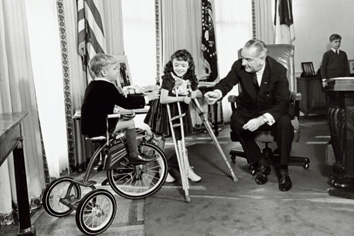As with any law — especially one with a long reach and a life of at least 50 years — a patchwork of changes has adjusted Medicaid this way and that. Overall, the changes have expanded the list of people who are eligible for Medicaid and given them a broader array of care options.
To celebrate Medicaid's 50th anniversary, here is a timeline of the law's evolution.
1960s & '70s

Recommended For You
Photo: United States President Lyndon Johnson talking with two disabled children at the White House. Washington, 1960s. Mondadori/Newscom.
July 30, 1965: The Social Security Amendments of 1965 establishes Medicare and Medicaid to cover health care for poor children, caretakers, the elderly, the blind, and people with disabilities.
January 23, 1967: Children receiving Medicaid get mandated early and periodic screening, diagnosis and treatment services.
October 30, 1972: The Supplemental Security Income (SSI) program of cash assistance for the elderly and people with disabilities begins.
1980s
January 1, 1982: Arizona becomes the last state to start participating in Medicaid.
September 3, 1982: States get expanded ability to impose nominal cost-sharing on some Medicaid beneficiaries and services, and can extend Medicaid coverage to those who are under age 18 with disabilities that require institutional care, but are living at home.

July 18, 1984: Medicaid coverage is extended to children born after Sept. 30, 1983, in families eligible for Aid to Families with Dependent Children, as well as AFDC-eligible first-time pregnant women and pregnant women in two-parent unemployed families.
April 7, 1986: Medicaid covers all remaining AFDC-eligible pregnant women.
December 22, 1987: States can extend coverage to pregnant women and infants with family income at or below 185 percent of the federal poverty level.
July 1, 1988: States must use Medicaid funds to pay the Medicare premiums and cost sharing for low-income Medicaid beneficiaries with incomes below the federal poverty level.
1990s

November 5, 1990: The Medicaid prescription drug rebate program begins, requiring pharmaceutical manufacturers to give best-price rebates to states and the federal government.
January 1, 1995: The U.S. Congress passes and President Bill Clinton vetoes legislation converting Medicaid to a block grant to states.
August 22, 1996: Welfare reform ends the formal link between cash assistance (welfare) and Medicaid eligibility. States can't use federal Medicaid funds to cover non-emergency services for many lawfully present immigrants entering the U.S. on or after Aug. 22, 1996, during their first five years after establishing legal residence in the U.S.
August 5, 1997: States can use Medicaid to cover care for children with family incomes at 200 percent of the federal poverty level. States can also enroll Medicaid beneficiaries into managed care.
January 1, 1999: States can extend Medicaid coverage to working disabled individuals with incomes of 250 percent above the federal poverty level and impose income-related premiums.
June 22, 1999: States must provide community-based services to individuals for whom institutional care is inappropriate.
2000s to now
October 24, 2000: States can extend Medicaid coverage to uninsured women with breast or cervical cancer, regardless of income or resources.
December 8, 2003: A new law transfers drug coverage from Medicaid to Medicare for dual eligible beneficiaries, or individuals enrolled in both Medicare and Medicaid.
February 1, 2009: States can cover lawfully present immigrant children and pregnant women who have been residing in the U.S. for less than five years.
March 23, 2010: President Obama signs the Patient Protection and Affordable Care Act into law. The law expands Medicaid eligibility to nearly all adults with family income at or below 138 percent of the federal poverty level; brings simplified application and enrollment; increases the federal match rate for the newly eligible; creates the Center for Medicare and Medicaid Innovation to evaluate and share innovative payment and service delivery models across the country; and invests in information technology and data.

June 28, 2012: The U.S. Supreme Court upholds the constitutionality of PPACA, but makes Medicaid expansion effectively a state option.

January 1, 2014: Coverage becomes effective for millions of people who have become newly eligible through Medicaid expansion.
© 2025 ALM Global, LLC, All Rights Reserved. Request academic re-use from www.copyright.com. All other uses, submit a request to [email protected]. For more information visit Asset & Logo Licensing.







